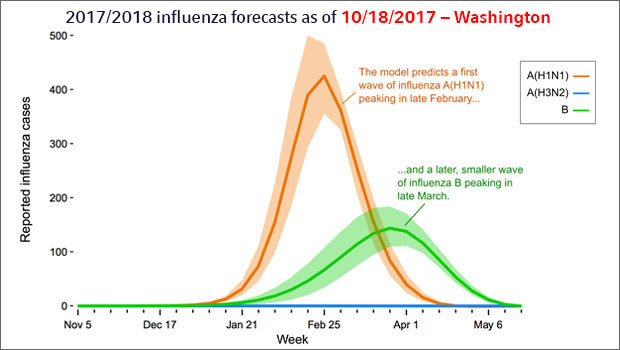Flu season is winding down — What did we learn?

Dr. Michael Jackson gives a late-season report on state and national influenza patterns and his Flucaster prediction model.
by Michael Jackson, PhD, MPH, Kaiser Permanente Washington Health Research Institute associate investigator
Influenza might not be headline news right now, because influenza activity is on the decline nationwide. But flu season isn’t over yet. Here in Washington state, we’re still in the midst of an epidemic of influenza B viruses. This “wave” of B viruses has not been as intense as the first wave of influenza A(H3N2) viruses that peaked in January, but it has been sustained for longer and is just starting to decline. The 2017–2018 flu season has been severe, with 252 confirmed deaths in our state due to influenza so far. This is nearly as many as were seen during 2016–2017 (278 total), which was the worst influenza season in Washington since the 2009 swine flu pandemic.
Flucaster performance
Back in October, our Flucaster — a computer model to forecast flu season timing and severity — predicted that Washington’s 2017–2018 influenza season would start with a wave of A(H1N1) viruses, peaking in January, followed by a smaller wave of influenza B. Although the season did have some circulation of A(H1N1) viruses, most of the first wave was A(H3N2) viruses. Enough A(H3N2) viruses had been seen by December 5, 2017 that our Flucaster started predicting some A(H3N2) cases. By December 18, the Flucaster predicted that A(H3N2) would be the dominant virus for the season. In addition, we did see a second wave of B viruses, as predicted, but the B wave was roughly twice as large as we originally predicted.
Why were our initial forecasts incorrect? Flu forecasts are often inaccurate when new virus variants emerge that spread more easily than the existing strains. While we have seen some new A(H3N2) viruses this year, they haven’t been the majority of viruses, so that doesn’t explain why the season was dominated by A(H3N2) rather than A(H1N1). The most likely explanation is that the past six influenza seasons, which we used to “train” our Flucaster, were unusual. Since 2011–2012, flu seasons have alternated between being dominated by A(H1N1) and A(H3N2). Because 2016–2017 was dominated by A(H3N2), the model predicted this year would mainly see A(H1N1). Historically speaking, however, regularly alternating years like this are uncommon. It’s more common to see multiple years dominated by A(H3N2) viruses.
What’s next?
My research group will continue to track influenza globally, all year long. Over the next months, we’ll keep an eye on the U.S. situation and turn our attention to the Southern Hemisphere, where flu season is just starting. We’ll keep feeding data into the Flucaster and work to improve the model.
Even as spring approaches, please stay vigilant. If you had the flu earlier this season, it might have been influenza A and you can still get sick from influenza B or another A type. Mark your calendar to get next year’s flu shot starting in the fall. And throughout the year, following tips about washing your hands, covering your cough, and staying home and resting if you are contagious is always a good idea.
Learn more about Kaiser Permanente Washington Health Research Institute. Sign up for our free monthly newsletter.


